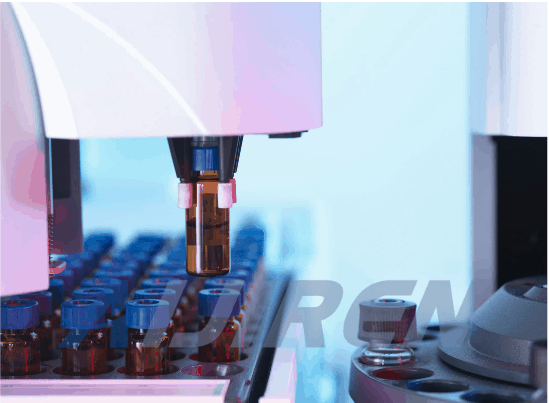Are autosampler vials reusable?
Chromatography autosampler vials are widely used in chromatography, chemistry, medical and other fields. Autosampler vials are generally made of hydrolytic glass or borosilicate, with various specifications. Different vial mouth designs meet different actual needs.
Chromatography sample vial is a glass vial used by automatic samplers and headspace samplers such as liquid chromatography, gas chromatography, mass spectrometry, etc. for chromatographic automatic sampling. Its basic requirements are accurate volume, ability to withstand a certain pressure, good sealing performance, and no adsorption to samples.
Factors Affecting Reusability:
Reusability of autosampler vials depends on several factors, including vial material, sample characteristics, cleanliness, and instrument compatibility. Let’s examine these factors in more detail:
- Vial material and quality:
The material and quality of the vial are critical considerations for reusability. Borosilicate glass vials are generally more durable and resistant to chemical interactions than plastic vials. Glass vials can often withstand repeated use without compromising their integrity. Plastic vials, on the other hand, may be more susceptible to wear and degradation, making them less suitable for extensive reuse.
2.Sample Characteristics:
The nature of the sample being analyzed is an important factor in determining the reusability of the vial. Some samples may leave residues or contaminants on the vial walls that may interfere with subsequent analyses. For example, samples with high salt content or volatile compounds may leave residues that could interfere with future analyses. In such cases, it is advisable to use new vials to ensure accurate and reliable results.
3.Cleanliness and Decontamination:
Proper cleaning and decontamination procedures are essential when considering reuse of autosampler vials. Thorough cleaning with appropriate solvents and techniques can remove residual sample components, reducing the risk of cross-contamination or carryover. However, complete removal of certain residues, such as highly adsorbed compounds, can be challenging and may compromise the integrity of subsequent samples.

4.Compatibility with the instrument:
Autosampler sampler vials must be compatible with the specific instrument and autosampler being used. Some instruments may have strict requirements for vial dimensions, thread sizes, or sealing mechanisms. Reusable vials must meet these compatibility criteria to ensure proper fit and function in the autosampler. It is important to consult the instrument manufacturer’s guidelines and recommendations.
Benefits and Limitations of Reusability:
Reusing autosampler vials can offer potential benefits, including reduced costs and environmental impact. By properly cleaning and reusing vials, researchers can minimize the waste generated by disposable vials. Reusability can also be advantageous when working with large sample sets or when sample volume is limited.
However, it is important to consider the limitations associated with reusability. Over time, vials can become worn, scratched, or degraded, compromising their integrity and performance. Residual contamination or carryover from previous samples can affect the accuracy and reliability of subsequent analyses. Researchers should carefully evaluate the trade-offs between cost savings and potential risks when deciding whether to reuse autosampler vials.
Best practices for vial reuse:
If you choose to reuse autosampler vials, it is important to follow best practices to maintain their performance and integrity:
1.Thoroughly clean vials using appropriate solvents and cleaning techniques to remove all traces of previous samples.
2.Inspect vials regularly for signs of wear, cracks, or damage that may affect performance.
3.Consider using disposable vial liners or inserts to minimize direct contact between the sample and the vial, thereby reducing the risk of contamination.
4.Establish a clear system for tracking vial usage and ensure proper documentation to prevent mix-ups or inadvertent mixing of samples.
5.Periodically validate vial cleanliness and performance through appropriate quality control measures such as blank runs or recovery testing.
In summary, although autosampler vials can be reused under certain circumstances, factors such as vial material, sample characteristics, cleanliness, and instrument compatibility must be carefully considered. Reusing vials can provide cost and environmental benefits, but it also carries the risk of contamination and compromised results. Researchers should evaluate these factors and follow best practices to ensure the integrity and reliability of their analyses. Ultimately, the decision to reuse autosampler vials should be based on a thorough assessment of the specific needs and constraints of each laboratory setting.
Back to List
-
 下午4:09Weighing the Pros and Cons of PTFE/Silicone Septa
下午4:09Weighing the Pros and Cons of PTFE/Silicone Septa -
 下午4:05Decoding Vial Discard Guidelines: Ensuring Precision in Chromatography
下午4:05Decoding Vial Discard Guidelines: Ensuring Precision in Chromatography -
 下午5:01Navigating Micro Inserts for HPLC Vials: A Comprehensive Guide
下午5:01Navigating Micro Inserts for HPLC Vials: A Comprehensive Guide -
.jpg) 下午2:02Common faults and solutions of automatic samplers(2)
下午2:02Common faults and solutions of automatic samplers(2) -
 下午5:08Ensuring Sample Integrity: Navigating EPA Storage Vials Stability Guidelines
下午5:08Ensuring Sample Integrity: Navigating EPA Storage Vials Stability Guidelines

